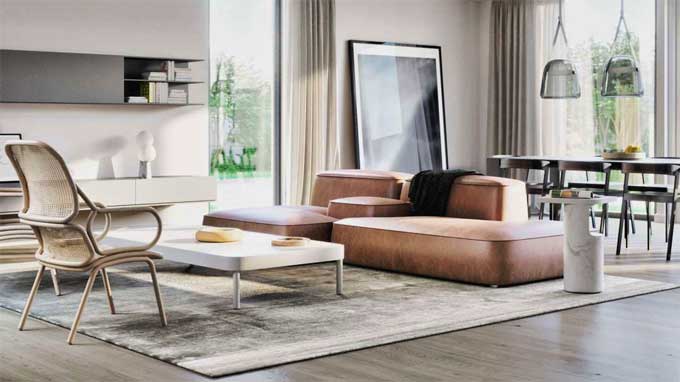How to Visualize & Render Furniture in 3D Modelling

There are a variety of applications for these 3D services, including design prototyping, production, and marketing. A 3D visualization and 3D furniture rendering allows furniture architects to make real time adjustments to their designs, can explore potential design variations, and present visually compelling options to their clients. It is possible to visualize and fine tune designs in a digital environment, which fosters collaboration and ultimately results in high quality furniture.
3D Furniture Visualization & Rendering Process
Utilizing specialized software, 3D models of the primary furniture product are created for visualizing and rendering. An artist creates the scene once the 3D model is created by either creating it from scratch or using an already created environment.
The next phase is to add materials and textures to all 3D items in the scene, including the main piece of furniture, in order to increase realism and aesthetic appeal. To provide a photorealistic appearance and appealing visuals, the 3D artist meticulously arranges the lighting and camera angles within the scenario. This arrangement makes sure that the furniture is displayed in an attractive manner.
Rendering the scene with the appropriate settings to create an image of excellent quality or 3D animation is the last stage. A precise and polished visual depiction of the furniture and its surroundings is produced by rendering. Any necessary post production work is completed in tools like Photoshop after rendering. To further improve the visual quality and accomplish the desired presentation of the furniture, the artist adds modifications and improvements to the produced output during post production.
Polygon Model Development
Once the item references have been delivered to the studio, the 3D modelling team will start working immediately away. First, the 3D artist will create a 3D furniture model from a collection of empty polygons. The camera angle will then be changed during the 3D furniture visualization in order to best display and highlight the product. To effectively showcase the various selling elements of any product, including furniture, three to five photos are already more than sufficient.
3D Scene Setup
It is important to consider both the setting as well as the furniture itself when creating a lifestyle image. A 3D furniture image must ensure that the furniture is the main focus while positioned in a natural and appealing environment. It is like an art form to achieve this delicate balance. A realistic 3D scene helps potential customers envision the furniture fitting into their homes or how it would look in their actual rooms.
Lighting Adjustment
An expert lifestyle picture emphasizes both the environment and the actual furniture. It is essential to make the furniture the focal point of 3D furniture photographs while presenting it in a beautiful and natural environment. This exact equilibrium resembles a subtle form of art. We can assist potential buyers in imagining how the furniture would look in a real room or how it would fit in their houses by creating a 3D environment that appears realistic.
The sort of furniture being shown and the location in which it is located are two things that have an impact on the lighting options. Despite minor elements such as lighting fixtures, lighting decisions need to be made. Professional 3D furniture rendering and visualization can suffer from any lighting flaws because they will be more obvious and affect the final product's quality.
Texturing
Another crucial step in the visualization and rendering of 3D furniture is texturing because each texture must be realistic and highlight the materials' quality. For example, countertops and lamp covers might become reflected, which is another reason for the careful visualization modifications.
Decoration Elements Addition and Photoshop Application
The process of visualizing and rendering 3D furniture is currently almost finished. The final step in furniture 3D modelling designers' work is to incorporate numerous decorative components to improve visual storytelling and establish the scene's context. The scene is then set to render after these components are in place, and the 3D modelling designer meticulously inspects the setup to make sure everything is done to the required standards.
A professional in Photoshop then refines the photographs by adjusting the colours and adding effects after 3D furniture rendering. They painstakingly retouch images to highlight furniture and its surroundings, luring customers in and expressing design sensibilities. High end 3D content creation requires talent and work but produces enticing, revenue boosting images that convey the required message.
To learn more, watch the following video tutorial.
Video Source: Derek Elliott
Wrapping it Up
The use of furniture CAD design professionals in the 3D furniture visualization and 3D furniture rendering process ensures high quality renderings that contribute to business growth and success.
The importance of working with trustworthy, reliable specialists is vital to building your business's competitive advantage. You can elevate your brand and make a lasting impression on the market by partnering with experts in the field.



